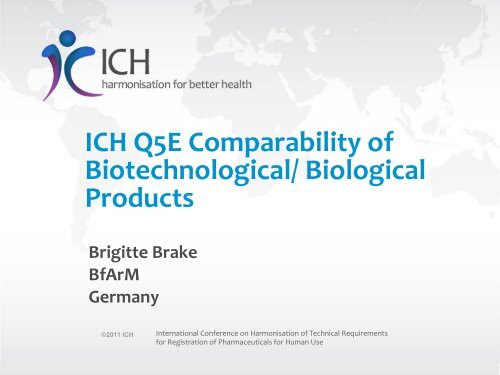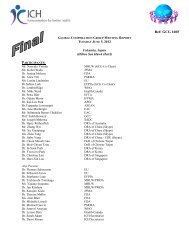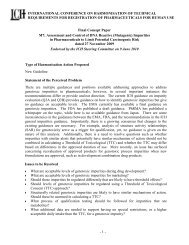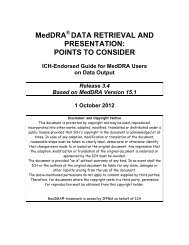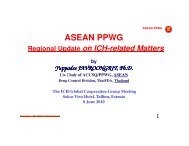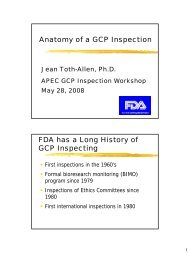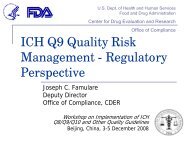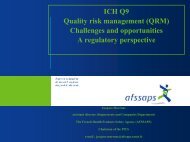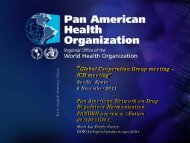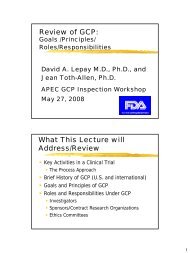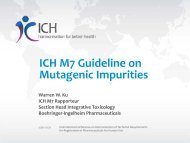ICH Q5E Comparability of Biotechnological
ICH Q5E Comparability of Biotechnological
ICH Q5E Comparability of Biotechnological
Create successful ePaper yourself
Turn your PDF publications into a flip-book with our unique Google optimized e-Paper software.
<strong>ICH</strong> <strong>Q5E</strong> <strong>Comparability</strong> <strong>of</strong><br />
<strong>Biotechnological</strong>/ Biological<br />
Products<br />
Brigitte Brake<br />
BfArM<br />
Germany<br />
©2011 <strong>ICH</strong> International Conference on Harmonisation <strong>of</strong> Technical Requirements<br />
for Registration <strong>of</strong> Pharmaceuticals for Human Use<br />
© 2011 <strong>ICH</strong> 1
Disclaimer:<br />
•The information within this presentation is based on<br />
the presenter's expertise and experience, and<br />
represents the views <strong>of</strong> the presenter for the<br />
purposes <strong>of</strong> a training workshop.<br />
© 2011 <strong>ICH</strong> 2
main emphasis <strong>of</strong> the<br />
document is on quality<br />
aspects
General Considerations<br />
•Changes to the manufacturing processes <strong>of</strong><br />
biotechnological/biological products both during<br />
development and after approval are normal and expected<br />
•Reasons for changes include improving the manufacturing<br />
process, increasing scale, improving product stability, and<br />
complying with changes in regulatory requirements.
Scope<br />
Applies to:<br />
• Proteins and polypeptides, their derivatives, and products <strong>of</strong> which<br />
they are components, e.g., conjugates. These proteins and<br />
polypeptides are produced from recombinant or non-recombinant cellculture<br />
expression systems and can be highly purified and<br />
characterised using an appropriate set <strong>of</strong> analytical procedures<br />
(same as <strong>ICH</strong> Q6B, Q5C)<br />
• Products where manufacturing process changes are made by a single<br />
manufacturer, including those made by a contract manufacturer, who<br />
can directly compare results from the analysis <strong>of</strong> pre-change and postchange<br />
product;<br />
• Products where manufacturing process changes are made in<br />
development or for which a marketing authorisation has been granted.
The process is the product<br />
• The entire manufacturing process determines the quality <strong>of</strong> a<br />
biotech product<br />
• Raw-/Starting Materials<br />
• Fermentation<br />
• Purification<br />
• Formulation<br />
• Minor process changes can have an impact on the quality
Quality pr<strong>of</strong>ile
Classification <strong>of</strong> changes<br />
„major“ or „minor“<br />
• no a priori prediction<br />
• any changes („minor“ or „major“) can have an impact on<br />
Q, S, E<br />
• the implication <strong>of</strong> a change can not be predicted
Quality assessment<br />
Product A / Process A<br />
Control <strong>of</strong> raw and<br />
starting materials<br />
Good<br />
manufacturing<br />
Practice<br />
Process<br />
validation<br />
QUALITY<br />
PROFILE<br />
In Process<br />
Control<br />
Control <strong>of</strong> cell<br />
substrate & cell bank<br />
Control <strong>of</strong> drug<br />
substance and drug<br />
product<br />
Safety & Efficacy pr<strong>of</strong>iles<br />
A
Quality assessment<br />
Product A1 / Process A1<br />
Control <strong>of</strong> raw and<br />
starting materials<br />
Product A2 / Process A2<br />
Control <strong>of</strong> raw and<br />
starting materials<br />
Good<br />
manufacturing<br />
Practice<br />
Process<br />
validation<br />
QUALITY<br />
PROFILE<br />
Control <strong>of</strong> cell<br />
substrate & cell bank<br />
Control <strong>of</strong> drug<br />
substance and drug<br />
product<br />
?<br />
Good<br />
manufacturing<br />
Practice<br />
Process<br />
validation<br />
QUALITY<br />
PROFILE<br />
Control <strong>of</strong> cell<br />
substrate & cell bank<br />
Control <strong>of</strong> drug<br />
substance and drug<br />
product<br />
In Process<br />
Control<br />
In Process<br />
Control<br />
Safety & Efficacy pr<strong>of</strong>iles<br />
A1<br />
?<br />
Safety & Efficacy pr<strong>of</strong>iles<br />
A2
<strong>Comparability</strong> (<strong>ICH</strong> <strong>Q5E</strong>)<br />
•<strong>Comparability</strong> exercise:<br />
o Goal: to ascertain that pre- and post-change drug product is<br />
comparable in terms <strong>of</strong> quality, safety, and efficacy.<br />
o<br />
to collect relevant technical information which serves as<br />
evidence that the manufacturing process changes will not<br />
have an adverse impact on the quality, safety and efficacy <strong>of</strong><br />
the drug product<br />
© 2011 <strong>ICH</strong>
<strong>Comparability</strong> (<strong>ICH</strong> <strong>Q5E</strong>)<br />
•Demonstration <strong>of</strong> comparability:<br />
o Does not necessarily mean that the quality attributes <strong>of</strong> the<br />
pre-change and post-change products are identical but highly<br />
similar<br />
o Ensure that differences in quality attributes have no adverse<br />
impact upon safety or efficacy <strong>of</strong> the drug product.<br />
o Based on combination <strong>of</strong> analytical testing, biological assays<br />
± nonclinical and clinical data<br />
© 2011 <strong>ICH</strong>
<strong>Comparability</strong> (<strong>ICH</strong> <strong>Q5E</strong>)<br />
Evaluation <strong>of</strong> Quality attributes<br />
no difference observed<br />
differences observed<br />
- Q “highly<br />
similar”<br />
& no doubt on<br />
analytical<br />
procedure<br />
- No impact on<br />
S/E forseen<br />
- Q “highly<br />
similar”<br />
but doubt on<br />
analytical<br />
procedure<br />
- Q “highly<br />
similar” but<br />
differences<br />
observed<br />
- No impact on<br />
S/E expected<br />
based on<br />
experience &<br />
relevant data<br />
- Q “highly<br />
similar” but<br />
differences<br />
observed<br />
- Impact on S/E<br />
cannot be<br />
excluded<br />
- Q significant<br />
differences<br />
considered<br />
comparable<br />
consider nonclinical/<br />
clinical studies<br />
may be<br />
considered<br />
comparable<br />
consider nonclinical/<br />
clinical studies<br />
Not<br />
comparable /<br />
out <strong>of</strong> scope<br />
© 2011 <strong>ICH</strong>
<strong>Comparability</strong> (<strong>ICH</strong> <strong>Q5E</strong>)<br />
• <strong>Comparability</strong> exercise: Extent <strong>of</strong> data depend on:<br />
- Step where the change is introduced<br />
- Potential impact <strong>of</strong> the change<br />
- Suitability <strong>of</strong> analytical techniques<br />
- Knowledge <strong>of</strong> the product & relationship between quality attributes and<br />
safety and efficacy<br />
• Determination <strong>of</strong> comparability<br />
o Combination <strong>of</strong> analytical testing, biological assays,<br />
non-clinical and clinical data in some cases<br />
o Demonstration <strong>of</strong> highly similar Quality pr<strong>of</strong>iles<br />
- validation batches, recent batches<br />
- historical results, sample library<br />
o<br />
- stability pr<strong>of</strong>ile<br />
Justification <strong>of</strong> the suitability <strong>of</strong> the methods<br />
- appropriately selected to maximize the potential <strong>of</strong> detecting differences<br />
- specification: may not be sufficient<br />
- characterization: may be required
Considerations for the<br />
<strong>Comparability</strong> Exercise<br />
•The product should be evaluated at the process step most<br />
appropriate to detect a change in the quality attributes.<br />
•This may entail evaluating the product at multiple stages <strong>of</strong><br />
manufacture.<br />
• For example, even though all process changes occurred in<br />
the manufacture<strong>of</strong> the drug substance, in cases where the<br />
drug product could be impacted by the change, it might be<br />
appropriate to collect data on both the drug substance and<br />
the drug product tosupport the determination <strong>of</strong><br />
comparability.
Considerations for the<br />
<strong>Comparability</strong> Exercise<br />
Extent <strong>of</strong> the studies will depend on:<br />
• The production step where the changes are introduced;<br />
• The potential impact <strong>of</strong> the changes on the purity as well as on the<br />
physicochemical and biological properties <strong>of</strong> the product, particularly<br />
consideringthe complexity and degree <strong>of</strong> knowledge <strong>of</strong> the product<br />
(e.g., impurities, productrelatedsubstances);<br />
• The availability <strong>of</strong> suitable analytical techniques to detect potential<br />
productmodifications and the results <strong>of</strong> these studies;<br />
• The relationship between quality attributes and safety and efficacy,<br />
based onoverall nonclinical and clinical experience.
Considerations for the<br />
<strong>Comparability</strong> Exercise<br />
• Relevant physicochemical and biological characterisation data regarding<br />
quality attributes;<br />
• Results from analysis <strong>of</strong> relevant samples from the appropriate stages <strong>of</strong><br />
the manufacturing process (e.g., intermediate, drug substance, and drug<br />
product);<br />
• The need for stability data, including those generated from accelerated or<br />
stress conditions, to provide insight into potential product differences in<br />
the degradation pathways <strong>of</strong> the product and, hence, potential<br />
differences in product-related substances and product-related impurities;<br />
• Batches used for demonstration <strong>of</strong> manufacturing consistency;<br />
• Historical data that provide insight into potential “drift” <strong>of</strong> quality<br />
attributes with respect to safety and efficacy, following either a single or a<br />
series <strong>of</strong>manufacturing process changes.
<strong>Comparability</strong> (<strong>ICH</strong> <strong>Q5E</strong>)<br />
•Manufacturing process considerations<br />
o Well defined process + controls :<br />
- Assurance that product is produced in a consistent manner<br />
- Suitability <strong>of</strong> controls: confirm that process controls in the<br />
modified process provide similar or more effective control <strong>of</strong> the<br />
product quality, compared to the original process
<strong>Comparability</strong> (<strong>ICH</strong> <strong>Q5E</strong>)<br />
•Manufacturing process considerations<br />
o Critical control points in the manufacturing process that<br />
affect product characteristics,<br />
o e.g., the impact <strong>of</strong> the process change on the quality <strong>of</strong> inprocess<br />
materials, as well as the ability <strong>of</strong> downstream steps<br />
to accommodate material from a changed cell culture<br />
process;<br />
o Adequacy <strong>of</strong> the in-process controls including critical control<br />
points and inprocess testing: In-process controls for the postchange<br />
process should be confirmed, modified, or created, as<br />
appropriate, to maintain the quality <strong>of</strong> the product;
<strong>Comparability</strong> (<strong>ICH</strong> <strong>Q5E</strong>)<br />
• Manufacturing process considerations<br />
o<br />
o<br />
o<br />
o<br />
confirm that the process controls in the modified process provide at<br />
least similar or more effective control <strong>of</strong> the productquality, compared<br />
to those <strong>of</strong> the original process,<br />
identify which tests should be performed during the comparability<br />
exercise, which in-process or batch release acceptance criteria or<br />
analytical procedures should be re-evaluated and which steps<br />
process assessment should consider such factors as the criticality <strong>of</strong><br />
the process step and proposed change, the location <strong>of</strong> the change<br />
and potential for effects on other process steps, and the type and<br />
extent <strong>of</strong> change.<br />
Use <strong>of</strong> proir knowledge from process development studies, small scale<br />
evaluation/validation studies, experience with earlier process changes,<br />
experience with equipment in similar operations, changes in similar<br />
manufacturing processes with similar products, and literature.
<strong>Comparability</strong> (<strong>ICH</strong> <strong>Q5E</strong>)<br />
•Manufacturing process considerations<br />
•Demonstration <strong>of</strong> state <strong>of</strong> control with the<br />
modified/changed manufacturing process. e.g.<br />
o Establishment <strong>of</strong> modified specifications for raw, source and<br />
starting materials,and reagents;<br />
o Appropriate bioburden and/or viral safety testing <strong>of</strong> the postchange<br />
cell banksand cells at the limit <strong>of</strong> in vitro cell age for<br />
production;<br />
o Adventitious agent clearance;<br />
o Removal <strong>of</strong> product- or process-related impurities, such as<br />
residual host cell DNAand proteins;<br />
o Maintenance <strong>of</strong> the purity level.
Analytical Considerations<br />
• The battery <strong>of</strong> tests should be selected and optimised to maximise the<br />
potential for detecting relevant differences in the quality attributes<br />
address the full range <strong>of</strong> physicochemical properties or biological<br />
activities,<br />
• It might be appropriate to apply more than one analytical procedure to<br />
evaluate the same quality attribute using methods employing different<br />
physicochemical or biological principles<br />
• There might be limitations <strong>of</strong> the assays (e.g., precision, specificity, and<br />
detection limit) and the complexity <strong>of</strong> some products due to molecular<br />
heterogeneity.<br />
• Do existing tests remain appropriate for their intended use or shouldbe<br />
modified?<br />
• Need to add new tests as a result <strong>of</strong> changes in quality attributes that<br />
the existing methods are not capable <strong>of</strong> measuring ??
Analytical Considerations<br />
Additional characterisation might be indicated in some cases<br />
• For example, when Process changes result in a product characterisation<br />
pr<strong>of</strong>ile that differs from that observed in the material used during<br />
nonclinical and clinical studies or other appropriate representative<br />
materials (e.g., reference materials, marketed batches), the significance <strong>of</strong><br />
these alterations should be evaluated.<br />
o Physicochemical Properties<br />
o Biological Activity<br />
o Immunochemical Properties<br />
o Purity, Impurities, and Contaminants<br />
o Specifications<br />
o Stability
Analytical Considerations -<br />
Stability<br />
•Slight modifications <strong>of</strong> the production procedures might cause<br />
changes in the stability <strong>of</strong> the post-change product.<br />
•Any change with the potential to alter protein structure or purity<br />
and impurity pr<strong>of</strong>iles should be evaluated for its impact on<br />
stability.<br />
•Stability studies might be able to detect subtledifferences that<br />
are not readily detectable by the characterisation studies.<br />
o buffer composition,<br />
o processing and holding conditions, use<br />
o organic solvents<br />
o trace amounts <strong>of</strong> a protease.<br />
o Changes <strong>of</strong> might only be detected by productd egradation<br />
that occurs over an extended time period;
Analytical Considerations<br />
•Real-time/real temperature stability studies<br />
•Accelerated and stress stability studies to establish<br />
degradation pr<strong>of</strong>iles and provide a further direct<br />
comparison <strong>of</strong> pre-change and post-change product.<br />
•<strong>ICH</strong> Q5C and Q1A(R) should be consulted to determine the<br />
conditions f
<strong>Comparability</strong> (<strong>ICH</strong> <strong>Q5E</strong>)<br />
•<strong>Comparability</strong> exercises during development:<br />
o Generally performed to demonstrate that nonclinical / clinical data<br />
generated with pre- and post-change products are applicable ---<br />
ultimately, to support the marketing authorisation<br />
•Takes into consideration stage <strong>of</strong> development, availability <strong>of</strong><br />
analytical procedures and the available experience<br />
o If change introduced before non-clinical studies: generally not an<br />
issue<br />
o If introduced in late stages: may be as comprehensive and<br />
thorough as the one conducted for an approved product
<strong>Comparability</strong> (<strong>ICH</strong> <strong>Q5E</strong>)<br />
•<strong>Comparability</strong> exercises during development:<br />
o Appropriate assessment tools needed<br />
o Analytical procedures used during development might not be<br />
validated, but should always be scientifically sound and provide<br />
results that are reliable and reproducible.<br />
o Due to the limitations <strong>of</strong> the analytical tools in early clinical<br />
development, physicochemical and biological tests alone might be<br />
considered inadequate to determine comparability, and therefore,<br />
bridging non-clinical and/or clinical studies might be needed.
% Tetraantennäre Form<br />
Example “Historical Data“<br />
60<br />
Phase III Batches<br />
50<br />
40<br />
30<br />
20<br />
10<br />
0<br />
Commercialisation<br />
Change <strong>of</strong> the manufacturing process<br />
0 5 10 15 20 25 30<br />
Chargen
Choosing the „right“ batches<br />
60<br />
50<br />
Batches for PK Studies<br />
upper<br />
Limit<br />
40<br />
30<br />
20<br />
lower<br />
Limit<br />
10<br />
0<br />
Change in the manufacturing process<br />
0 5 10 15 20 25 30<br />
Batch
Potency units/ml<br />
Examle for accelerated<br />
studies<br />
Storage temperature <strong>of</strong> the product is 5°C<br />
(Spec for potency 80-120 IU/ml (100 IU/ml)<br />
120<br />
100<br />
25 o C<br />
80<br />
60<br />
Pre-Change Product<br />
Post-Change Product<br />
40<br />
20<br />
40 o C<br />
0<br />
1 2 3 4 5 6<br />
Time (days)
Immunogenicity <strong>of</strong><br />
Therapeutic Proteins<br />
• It is impossible to predict<br />
o immunogenicity with analytical methods<br />
o the incidence <strong>of</strong> unwanted immunogenicity<br />
o the characteristics <strong>of</strong> the immune repsonse<br />
o the clinical consequences & significance <strong>of</strong> such<br />
immunogenicity<br />
• Immunogenicity to changes that can not be determined by<br />
analytical means<br />
• Unwanted immunogenicity needs to be investigated in<br />
appropriate studies
Immunogenicity <strong>of</strong><br />
Therapeutic Proteins<br />
• Majority <strong>of</strong> biotherapeutics is immunogenic, both from animal<br />
and human origin<br />
immunogenicity no specific problem <strong>of</strong> biosimilars<br />
• Currently available biosimilars <strong>of</strong> first generation biotherapeutics<br />
(copies <strong>of</strong> endogenous GF or hormones)<br />
• Development <strong>of</strong> Ab<br />
- Normal reaction to a foreign protein (e.g. protein <strong>of</strong> animal<br />
origin, gene deletion)<br />
- Breaking the normally existing immune tolerance to self<br />
antigens
Factors influencing<br />
Immunogenicity<br />
Proteinstructure/-size<br />
Glycostructures<br />
Purity Impuritiy<br />
Formulation,<br />
Stability,<br />
Degradation<br />
Administration, Dose,<br />
Frequency, Co-Medication<br />
MHC, Genotype,<br />
Disease, Age
Product-specific causes<br />
Factors Causing<br />
Immunogenicity<br />
• Structural differences exogenous/endogenous protein<br />
• Structural alterations<br />
- Aggregation<br />
- Degradation – oxidation, deamidation,<br />
- Conformational changes<br />
• Storage conditions<br />
• Impurities / contaminants<br />
• Formulation
Hierarchy <strong>of</strong> Risk <strong>of</strong> Immune<br />
Response to Therapeutic<br />
Proteins: Product Factors<br />
• Post-translational Modifications<br />
o Aggregation<br />
o<br />
o<br />
o<br />
o<br />
o<br />
o<br />
o<br />
o<br />
o<br />
Oxidation<br />
Aldehyde Formation<br />
Glycosylation (or lack there<strong>of</strong>)<br />
Truncation<br />
Deamidation<br />
Citrullination (Deimination)<br />
Phosphorylation<br />
Arginine methylation<br />
Others<br />
as presented by<br />
Dr. A. Rosenberg, FDA, USA
Frequency <strong>of</strong> PRCA and changes <strong>of</strong> the<br />
formulation for EPREX 1998<br />
pre-filled syringes<br />
Coated Stoppers<br />
Polysorbate 80<br />
67 72 17<br />
HSA<br />
28<br />
0 0 1 0 1 0 0 1 0<br />
6 8<br />
6<br />
0<br />
1989 1990 1991 1992 1993 1994 1995 1996 1997 1998 1999 2000 2001 2002 2003 2004 2005
Thank You!<br />
Acknowledgement:<br />
Kowid Ho, Afassps,<br />
France<br />
©2011 <strong>ICH</strong> International Conference on Harmonisation <strong>of</strong> Technical Requirements<br />
for Registration <strong>of</strong> Pharmaceuticals for Human Use<br />
© 2011 <strong>ICH</strong> 37


